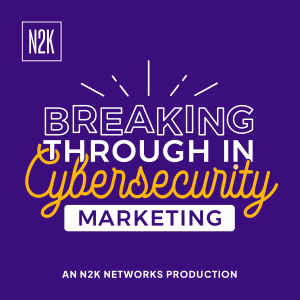
Wednesday Jan 04, 2023
(MOp)ping the Floor in Operational Hygiene with Nick Hayes
This week on Breaking Through in Cybersecurity Marketing, Gianna and Maria sit down with Nick Hayes, Product Marketing Manager at Crowdstrike. During the episode, Nick shares how he went from working as an analyst at Forrester to becoming a cybersecurity marketer. Nick shares how his experience as an analyst translates to his role as PMM as Gianna and Maria ask him fascinating questions. Learn more about being a PMM and listen in to hear Nick share some wisdom that, Maria says, you might not find anywhere else as a marketer.
Timecoded Guide:
[05:01] Becoming an internal marketer and shifts Nick made in his new role
[10:15] Day in the life of a PMM at Crowdstrike
[13:07] Operational Hygiene
[16:03] Balance between internal and external marketing
[18:53] Future of product marketing
What was the biggest challenge to overcome moving from analyst to internal marketer?
Nick shares how he had to go from being an adviser to meeting many new challenges as an internal marketer. He says that, while marketers and analysts have a lot in common, marketers align to business objectives differently than analysts. Instead of writing reports, for example, Nick says that marketers have to come up with plans to generate leads and hit specific metrics while defining certain performance goals.
“In some cases, especially at the startups that I worked at, it was a lot more of ‘you need to define what those metrics and what those performance goals are.’ So that's really, I'd say the biggest challenge, but also something I was kind of looking to do, I wanted to see that, I wanted to experience that.”
What do you wish could happen in the future from an analyst and security vendor relationship standpoint?
Nick highlights the analyst/vendor relationship here, saying that both roles can learn a lot from each other. In a way, Nick says that vendors and analysts fill in gaps for one another, learning vital information from their colleagues who serve as subject matter experts in their respective fields. As for the future of this dynamic, Nick says that marketers will often brief analysts once, thinking that as long as the presentation is perfect, no more work needs to be done. Nick says this changes by following up with analysts after presentations while fostering an ongoing relationship between the two roles.
“You can learn a lot if you are in the right mindset as an analyst. And I think that two-way, that back-and-forth interaction that you have between the vendor and the analyst, you can be a really positive push and pull.”
What’s a day in the life of a PMM at Crowdstrike?
Working for Crowdstrike as a PMM is different every day, Nick says. He says that, at the company, they’re dealing with a good problem to have: they’re growing too quickly. The company is a product of its own success as it became public in 2019 and has continued to grow exponentially from its founding in 2011. Nick says that the company has had to evolve quickly as it has rapidly hit certain benchmarks. Amid the growth, Nick has had to ensure good visibility within the company as he’s worked to make sure that products are understood and fit within the broader context of what Crowdstrike does.
“A lot of the ways in which your company is producing and performing at that level, you have to evolve quickly to adapt as your company reaches these, you know, amazing benchmarks. And in some ways, when you are just continually successful, you're somewhat a product of your own success, right?”
What is operational hygiene?
One of the things that Nick emphasizes is important as a PMM in operational hygiene. Gianna asks what that is and how, as a PMM, Nick ensures that the hygiene is operationally sufficient. Nick shares that operational hygiene is asking this: how do we do things more consistently and how do we make sure there’s documentation to support the repeatable workflows that we’re doing? In a product launch, for example, good operational hygiene means finding out what the launch looks like, who should be involved, and what the steps are. He says that, ultimately, it comes back to MOps and demand gen while ensuring that things stay consistent.
“It's thinking about how we actually understand our business from a demand gen perspective, and being able to slice and dice data and tag it in different ways so that we can be nimble and the data support and can be used and fits a number of different product teams within the company.”
----------
Definitions:
IPO: IPO stands for initial public offering, which is when a company goes on the stock market, making stock shares available to investors for the first time.
MOps: Standing for marketing operations, MOps refers to the functions of ensuring that marketing activities and business objectives align, overseeing and planning campaigns, optimizing people, and managing brand compliance.
Demand Gen: Demand gen is a term that encompasses an activity in marketing that drives brand awareness and interest in a service or product.
Links:
Keep up with Nick Hayes on Twitter and connect on LinkedIn.
Follow CrowdStrike on LinkedIn and Twitter.
Visit CrowdStrike’s website.
Keep up with Hacker Valley on our website, LinkedIn, Instagram, and Twitter.
Follow Gianna on LinkedIn.
Catch up with Maria on LinkedIn.
Join the Cybersecurity Marketing Society on our website, and keep up with us on Twitter.
No comments yet. Be the first to say something!